Context Free grammar
Context Free (CF) grammars rely on shape grammars. A shape grammar consists of a set of transformation and production rules. It applies a step-by-step way to generate and operate on a set, or language, of designs (1). The rules of a shape grammar defines how an existing (part of a) shape can be changed. Such rules operate on design elements to compute designs. Context Free Drawing or CFDG generates images from a written grammar (i.e. cfdg file) (2). The program follows the instructions or set of rules.
An example usage is as follows: $ ./cfdg instructions.cfdg img.png
Shapes
Shape grammars rely on shape elements or facts. They are often: points, lines, planes, etc. A shape rule can be written as follows to display either a triangle, or a square, or a circle. A shape rule starts with startshape.
startshape draw
rule draw {
TRIANGLE {}
}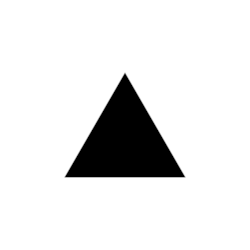
Geometry
Spatial rules employ shape operations of addition, subtraction, and many components of the procrustes analysis such as: translation, skew, rotation, uniform scaling, etc. For example, the translation of a shape along the x-axis is made using the adjustment x, as seen below.
startshape draw
rule draw {
TRIANGLE {}
CIRCLE {x 1}
}startshape draw
rule draw {
TRIANGLE {}
draw {x 1 s 0.7}
}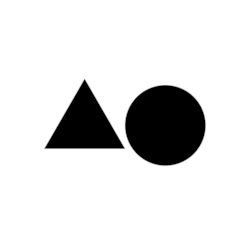
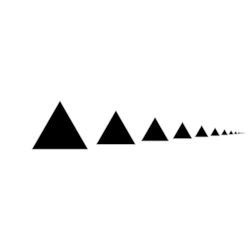
The second grammar is recursive and employs a new adjustment of size or s. The program stops once the triangle size can no longer be represented on the image space.
Color
CF uses the HSBA color space. The HSBA coordinates are [0,360] for hue, [0,1] for saturation, [0,1] for brightness, and [0,1] for alpha (opacity). When brightness is set to 0 or 1, the result is white and black, respectively.
startshape cc
rule cc {
CIRCLE {sat 1 hue 0 b 1}
CIRCLE {sat 1 hue 120 b 1 x 1}
CIRCLE {sat 1 hue 240 b 1 x 2}
CIRCLE {sat 1 hue 180 b 1 y -1}
CIRCLE {sat 1 hue 300 b 1 x 1 y -1}
CIRCLE {sat 1 hue 60 b 1 x 2 y -1}
}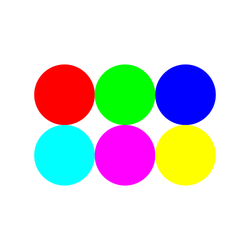
Time
CF is powerful enough to render an animation or a set of frames. Each shape has a start time, when it starts to be drawn, and an end time, when it’s drawn. This defines a 1D affine transform with a pair that share the same scale element. The adjustments are time and timescale.
startshape draw[timescale 0.01]
CF::Time = [time 0 1]
shape c{
CIRCLE[]
}
shape draw
{
c[x ftime()]
draw[x 0.1 r 4 time 1 0 x 0.1]
}
By default, CF accumulates the existing time for all of the primitive shapes and divides this time span evenly for each animation frame. In this case the timescale adjustment creates 11 steps given the time adjustment from 0 (inclusive) to 1. To generate the animation:
$ ./cfdg -a 5 instructions.cfdg img.png
$ convert img_*.png animation.gif
Sierpinski triangle
To demonstrate the power of CF, let’s create the Sierpinski triangle (3).
startshape draw
rule tr{
TRIANGLE{}
}
rule draw {
tr{b 0.01} // for better contrast
draw {s 0.5 y 0.288 b 0.1}
draw {s 0.5 x -0.25 y -0.144 b 0.1}
draw {s 0.5 x 0.25 y -0.144 b 0.1}
}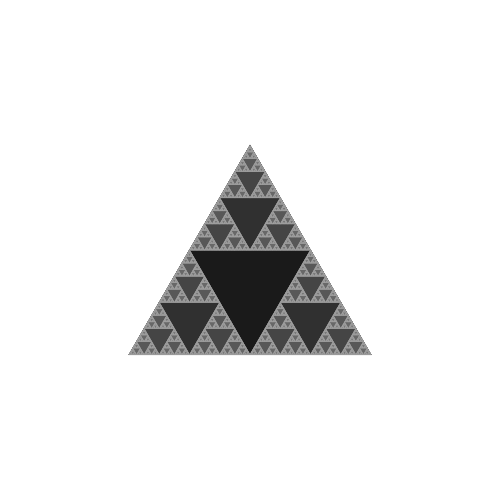
Shapes
From the ancient Egyptians’ fixed rules of a canon, a measurement that is based on the square, to the proportions of the gothic style, to the halos depicted around Catholic saints, to circles for Muslim talismans, to triangles in the star of David, to the Shinto principles of ‘Sanmi-sangen’, these shapes cross religious and spiritual lines. Acknowledging the three most basic and commonly used shapes is key to understanding both ancient and modern art: the square, the circle, and the triangle.
In the early 1960s Italian designer Bruno Munari published his visual case studies on these fundamental forms.
From the ring, to the quadra, to the three angles shape, intricate patterns can be created. Below, I rediscover them in a more organic manner using shape grammars.

For complete documentation, the official wiki details shape adjustements, shape replacements, shape rules, expressions, and control structures (4).
- Knight, T., 1999. Shape Grammars in Education and Practice: History and Prospects.
- Coyne, C. and Horigan, J. and Lentczner, M. Context Free Art.
- Conversano, E. and Tedeschini-Lalli, L., 2011. Sierpinski Triangles in Stone on Medieval Floors in Rome, APLIMAT Journal of Applied Mathematics, 4: 114, 122.
- Context-free by John Horigan. Wiki.
